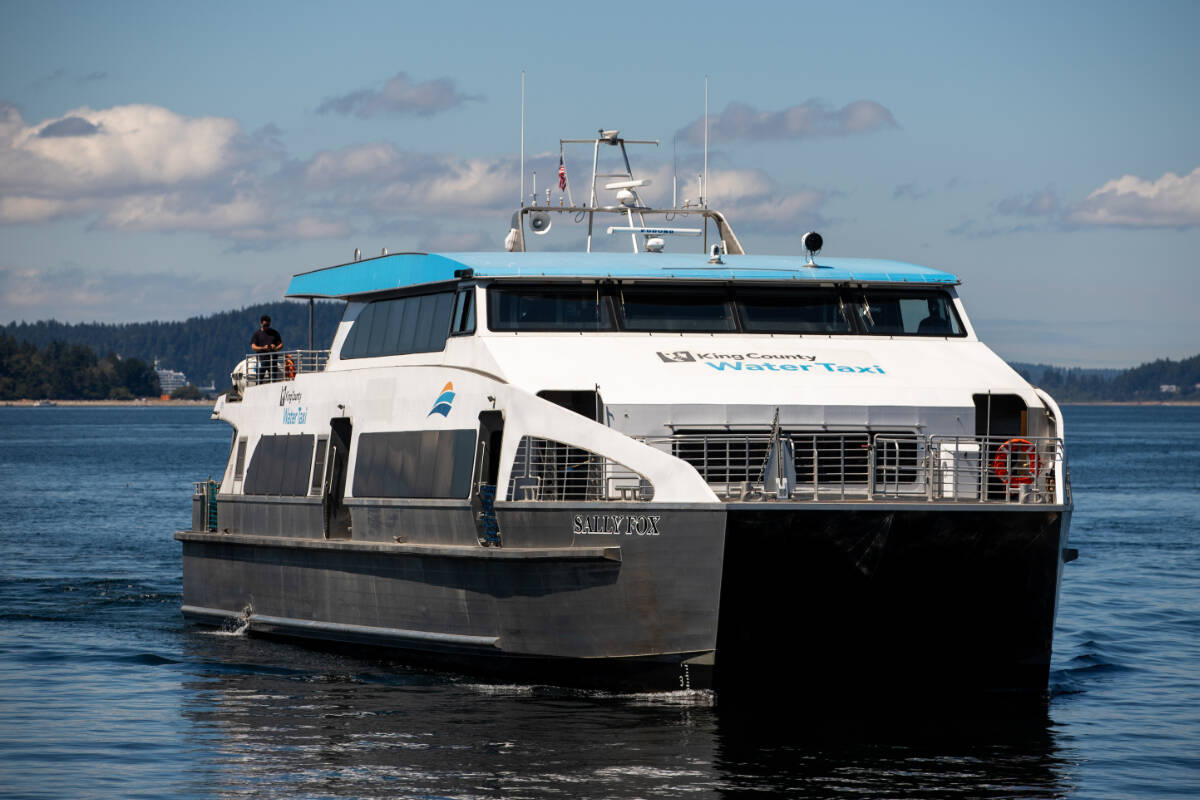Ridership on the King County Water Taxi between Vashon and downtown Seattle jumped 55 percent during the last six months of 2024, almost entirely because of new sailings in the middle of the day.
King County Metro launched four weekday midday roundtrips last July 1, supplementing the six total roundtrips it previously had offered during peak morning and evening commute hours.
Ridership numbers provided by Metro to The Beachcomber last week show total ridership on the route from July through December topped 69,000, up from fewer than 45,000 during the same six months in 2023.
Passengers on the new midday sailings accounted for more than 21,000 of those 24,000-plus additional trips.
“The residents of Vashon asked for increased service, and they have been taking advantage of [it],” Metro spokesman Al Sanders said.
“We’re heartened that ridership numbers bear out the need for expanded water taxi and marine transit options for Vashon,” said Amy Drayer of Islanders for Ferry Action, an advocacy group convened last year by the Vashon Island Chamber of Commerce that has lobbied hard for the new sailings.
Midday service commenced last summer after the state Legislature appropriated $3.17 million to fund it. The added trips were intended to provide some relief for the hardships and inconvenience islanders have endured as Washington State Ferries’ (WSF) car-ferry service between Vashon and Fauntleroy has become more infrequent and less reliable in recent years.
That appropriation expires June 30. Drayer and state Rep. Greg Nance, D-Bainbridge Island, who represents a district that also received state funding last year to expand water taxi service, said they’re optimistic the Legislature will continue funding for an additional two years in the 2025-2027 transportation budget.
But it’s not a sure thing, they added. “The budget fight will be difficult this year,” Drayer said.
The Legislature, which convened Monday, must address significant budget gaps this session. For transportation, the latest revenue forecast for the coming two-year biennium is 8 percent lower than was forecast in 2022, according to a staff presentation last month to the Senate Transportation Committee.
That’s largely because gas-tax revenues now are projected to decline as more people choose electric vehicles. “Lawmakers will be looking for savings across the board,” Drayer said.
Outgoing Gov. Jay Inslee did include $4.77 million to continue Vashon’s midday water taxi service in the proposed transportation budget he unveiled last month. Together with existing funding, that amount “will likely be sufficient to cover the cost of midday service through the 2025-2027 biennium,” Metro’s Sanders said.
That’s encouraging, Drayer said. But the Legislature can, and always does, make numerous changes to what the Governor proposes. And Inslee is a lame duck; his term ends Wednesday (after The Beachcomber goes to press) when Bob Ferguson becomes the state’s chief executive.
Ferguson has expressed greater willingness than Inslee to consider budget cuts. But he also has identified fixing Washington State Ferries as a top priority. That’s a plus for Vashon and other ferry-dependent communities, Drayer and Nance said.
“We must commit to fixing our ferry system by improving reliability,” Ferguson said in a document last week outlining his budget priorities.
In that document, Ferguson said he supports $19.2 million in Inslee’s proposed transportation budget to beef up Washington State Ferries’ crew recruitment and retention, and to restore or increase WSF service in the San Juan Islands. He did not specifically mention Vashon or its water taxi.
Another plus for Vashon: Rep. Joe Fitzgibbon, D-West Seattle, whose 34th District includes the island, is the House Majority Leader, a powerful post. And his seatmate, Rep. Emily Alvarado, D-West Seattle, who spearheaded the effort to appropriate the original $3.17 million for the midday trips, is a “wonderful champion,” Nance said.
Alvarado could not be reached for comment by press time.
Despite those advantages, “in a highly competitive budget environment, we need to remind legislators that the crisis on our marine highways is far from over,” Drayer said.
Islanders for Ferry Action and advocacy groups from other ferry-dependent communities are planning “Fix our Ferries” lobby days in Olympia Feb. 4-6, with a focus on Vashon Feb. 5. “We’ll be encouraging island residents to join us to talk about water taxi, as well as WSF funding and accountability,” Drayer said.
Islanders for Ferry Action also has begun exploring options for additional passenger-only service between Vashon and the mainland.
It has retained marine transit consultant Peter Phillips of Normandy Park, who was involved in a demonstration project that ran passenger-only boats between Des Moines and downtown Seattle for two months in 2022.
While he acknowledges it’s all very preliminary, Phillips envisions a “Circle Route” between Vashon, downtown and Des Moines, initially operating nights and weekends — when the King County Water Taxi doesn’t run — and using much smaller, less-expensive boats. Metro shuttle buses might carry passengers from Des Moines to Seattle-Tacoma International Airport, he said.
Islanders for Ferry Action also is supporting what Nance calls his “Mosquito Fleet Act.” While it hadn’t been filed by press time, Nance said his bill would provide grants totaling $25 million to $40 million for passenger-ferry capital expenses, including boats.
The grants would be competitive, he said, and would be available not only to Puget Sound communities, but also to those on Grays Harbor and the Columbia River. A project like a Vashon-Seattle-Des Moines “Circle Route” might qualify, Nance said.
Money for the grants would come from previous, unspent appropriations for transportation projects that “now don’t meet community needs,” he added. He pointed to a proposed traffic circle on State Highway 305 on Bainbridge as an example.
Improving marine transit is a higher priority, Nance said: “We have huge needs, and we can’t wait for WSF.”
The first of a new generation of car ferries — perhaps the biggest piece of a long-term solution for improving Washington State Ferries service — isn’t expected until 2028 at the earliest.



